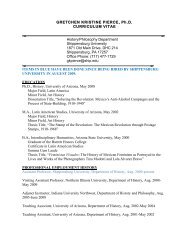Complete Issue - Shippensburg University
Complete Issue - Shippensburg University
Complete Issue - Shippensburg University
- No tags were found...
Create successful ePaper yourself
Turn your PDF publications into a flip-book with our unique Google optimized e-Paper software.
Evy Johanne Håland,: The “Life-giving Spring” 47article framed and glazed. Panagiotis tells me thathe put it up himself. He does not remember exactlywhen and where the article was published, only that he“found (i.e. read) it some years ago,…the year I was onTinos during the Panagia” (i.e. August 15, 1989). Thearticle describes the legend behind the cult dedicatedto the Panagia Crysospēliōtissa in this particular cave.Eirinē and Panagiotis recount the article in their ownway: “In the beginning of Christianity there was amiraculous icon in this cave. It was painted by Agios(i.e. the Evangelist) Luke (i.e. during Mary’s lifetime).Roxane, the daughter of a pagan medical doctor, wasapproached by Panagia in a dream, who asked theyoung woman “to set her free.” “She was imprisoned.”In other words, the iconwas buried here. 9 Afterthree dreams, Roxaneasked the other Christiansto go along with her. Bydigging up the icon, sheliberated the Panagia,who then appeared to herin a vision. The Panagiapromised to help Roxaneliberate Athens from theGoths. When their leader,Alaric, came, he wantedto destroy the city. Buta light appeared beforethem, 10 and Alaric, whowas a Christian himself,departed after recognizingan image of the Panagiaon the city-wall. The article also asserts many of thepagan Athenians interpreted the miracle in their ownway—they thought the goddess Athena, who wasbelieved to be the protector of her namesake city, hadappeared on the city-wall. The miracle happened inAugust 395 and therefore 15 August is celebrated herein commemoration of the miracle. 11 Unable to datethe article precisely, I am also aware of the potentialinterpretative biases of my informants. Their accountsof the article emphasize the magical powers of theicon, and we are able to see the similarities betweenthe pagan and Christian beliefs. Accordingly, they alsomaintain the icon was brought to the cave when peoplewho did not believe in Christianity were present. Thearticle does not say anything about that part of thestory. Instead, it recounts how the icon helped theAthenians save the city from the assault of the Goths. 12My informants tell me at an earlier time, they usedto be in both churches during the festival dedicatedto the Life-giving Spring. They always started in theLife-giving Spring, and sometimes they continuedthe celebration in the Crysospēliōtissa. In the cavededicated to Panagia Crysospēliōtissa, they perform amemorial service called “Nine days after the Dormition”on August 23. 13Plate 3: Eirinē Melas carries out the monthly cleaningof the Acropolis caves starting in the church dedicatedto the Life-giving Spring (author photograph).There were once two storeys separated by awooden-floor in the chapel dedicated to PanagiaCrysospēliōtissa. The upper-floor was situated wherethe ladder leading up to the icon of the SleepingPanagia (i.e. her Epitaphios) stops (cf. Plate 4). WhileEirinē is cleaning, she arranges the candelabra shebrought from the cave dedicated to the Life-givingSpring on a certain place, claiming this is where the“holy table” used to be, and “there was a church above,”referring to the second floor. 14 She continues explainingthis actual “upper” church “is named after the death or‘Dormition’ of the Panagia, because the icon from 1894depicts her death.” They decorate the icon with oliveoillamps and flowers. They also decorate the rest of thecave, but they leave all thelamps in front of the icon ofthe Panagia and the Child.When asked if the locationof the lamps is purposive,Eirinē replies “No.” Themost important icon wasactually moved to Moscow;only a copy remains in thecave. Many votive offeringshave been dedicated to thiscopy in the cave.The first time I visitedthe cave, August 19, 1990,I also saw icons dedicatedto the Panagia Athiniotissaand Agios Attikos. 15 Thecave contains many iconsof different saints (cf. Plate4), including Agios Constantine and Agios Gregorios.Several icons hang over older Byzantine frescos,which are not restored (i.e. in 1992). There is also apicture of the Holy Ephraim. He suffered martyrdomunder the Turks, who burned him. His remains arein a monastery, dating to the eleventh century, inthe neighbourhood of Nea Makri. According tomy informants, many miracles have occurred there:Panagiotis’ cousin Sophia, who was barren, reportedlybecame pregnant following a visit to the monastery. 16Religious symbols, stories, and legends play a centralrole in nurturing the faith of many followers. Duringmy visit, Panagiotis supplies me with several smallpictures of different saints and other gifts, for instancea medallion of Agios Pandeleimon, the Healer, thepatron-saint of invalids and cripples. I also received apicture representing a tree, which had a cross insideit when it was cut. 17 They also tell me a miracle hasprobably occurred recently in the church at Kypselidedicated to Agios Ephtimidios: Last week, they foundblood on the icon of Jesus Christ. They summonedexperts, who were unable to pinpoint the source of theblood. I also learn that some years ago, Eirinē foundall the icons broken when she arrived at the cavechurch.This is why both the churches are now locked
















